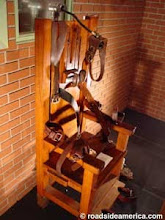Before the electric chair, committed felons who were sentenced to death were done so by Hangings. Most of these hangings were done in a public place and usually attended by a large group of people in the community and surrounding area. They were “carefully arranged beforehand and attended not only by the rabble, but by persons of rank and fashion, of
intelligence and sensibility.”[2] These hangings were done in the town or counties in which the
crimes were committed in, which caused problems based on the racial tensions that were so high in the state at this time. Sixty percent of those hung during this time period were African
American were as only a little over twenty five percent Anglo’s were hung. This went on until a man from the town of Rogers by the name of J.W. Thomas ran for state senate. His platform was based on that these hangings were unfit to take place in the cities in which the crimes had taken place in. He was the one who thought it would be better for these hanging to take place in a neutral setting, where both whites and blacks would be protected by the law. The place that was agreed upon was Huntsville, Texas.
[2] Marquart, Ekland-Olsen, Sorensen,The Rope, The Chair, and The Needle: Capital Punishment in Texas, 1923-1990. 1st ed. Austin, TX: University of Texas Press, 1994

